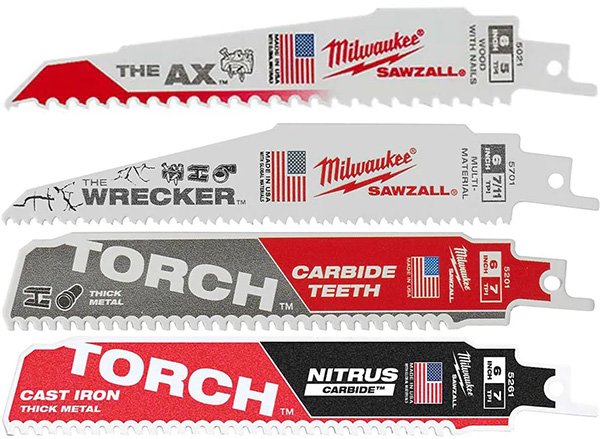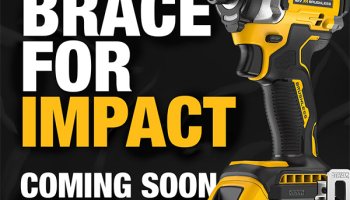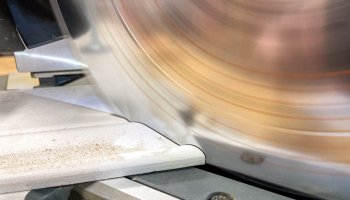
If you buy something through our links, ToolGuyd might earn an affiliate commission.
Shopping for reciprocating saw blades can be a daunting task these days, due to the sheer number of different options.
A reader wrote in today, asking for some help in making sense of all of Milwaukee Tool’s various Sawzall reciprocating saw blade options.
Milwaukee actually has 18 distinct categories of reciprocating saw blades listed on their website, but the selection becomes simplified once you understand what makes them different.
Milwaukee Premium Sawzall Blades
There are 3 product family names you need to know – The AX, Torch, and The Wrecker.
The AX blades are for wood-cutting.
TORCH blades are for cutting metal.
The WRECKER are multi-purpose types of blades for cutting wood, nail-embedded wood, plastics, and metal. It’s a general purpose-type of demolition blade.
These premium blades often have special features and tooth profiles to deliver faster cutting, longer life, and greater tooth durability.
There are 2 basic styles of blades – carbide and non-carbide, with bi-metal or ice-hardened teeth depending on the style.
The blades with carbide teeth are the longest-lasting (and also the most expensive).
Some of the styles are self-explanatory, such as The Ax with carbide teeth for pruning clean wood blade.
Milwaukee Standard Sawzall Blades

There are also “standard” Sawzall reciprocating saw blades.
Standard Metal Blades
Clean Wood Cutting Blades
Nail-Embedded Wood Blades
Standard Multi-Material Blades
Pruning Blades
Milwaukee Ice-Hardened Standard Sawzall Blades
Ice-hardened blades offer longer durability.
Ice Hardened Metal Blades
Ice Hardened Multi-Material Blades
Milwaukee Specialty Reciprocating Saw Blades

Tungsten Carbide Grit Blades – for cutting tile, masonry, fiberglass, and other abrasive materials.
There is a catch-all category for other specialty blade styles:
- Metal Scrolling
- Wood Scrolling
- Plaster
- Drywall Access
- Ductwork
- Rough In
- Flush Cut
- Brick and Block
How to Choose Milwaukee Sawzall Blades
Things get fairly straightforward once you sort blades according to what you’re cutting, such as wood, wood with nails, or metal.
Once you shop according to application, blades are generally sorted in “good, better, best” types of tiers.
For instance, if you need a pruning blade, you have two options – the standard Sawzall pruning blade, or The Ax pruning blade. From there, you choose the length. The standard blade is available in 9″ and 12″ lengths, and The Ax pruning blade is available in 6″, 9″, and 12″ lengths.
The premium specialty-named blades often have features that deliver greater performance. Aside from that, stepping up to different levels generally reflect differences in blade durability (and price).
For instance, a blade with ice-hardened teeth with usually last longer than standard blades, and blades with carbide teeth last longest.
Ice-hardened blades are said to last up to 50% longer than standard blades, and so you’ll have to do the math to see if they’re worth the price increase. (Personally, I don’t go out of my way to buy them.)
Wood-Cutting Reciprocating Saw Blades

Wood with Nails
- Basic: Standard
- Better: The Ax Nail-Embedded
- Best: The Ax with Carbide Teeth
Clean-cutting? There’s only one option.
Pruning? There’s a standard pruning blade and premium The Ax pruning blade with carbide teeth.
Metal-Cutting Reciprocating Saw Blades

- Basic: Standard
- Improved: Ice-Hardened Metal Blades
- Improved: Torch
- Better: Torch Ice Hardened
- Best: Torch with Carbide Teeth
There’s also the Sawzall Torch with Nitrus Carbide blade, for cutting cast iron and other thick metals. This blade is described as the next generation of carbide teeth technology, and so it’s marketed as being a level up from the Torch with carbide teeth.
Metal-cutting blades require additional sorting, as the TPI (teeth per inch) depend on the material being cut.
Some blades are suited for any metal cutting, but most are application-specific, such as for thin metal cutting (e.g. tubing or sheets) or thick cutting (e.g. pipes and structural parts). You will sometimes see a graphical depiction of a sheet or thin-wall tube for thin metal-cutting blades, and an I-beam for thick metal-cutting blades.
Milwaukee’s applications tables show the following recommendations:
- 10 TPI: threaded rod, schedule 80 pipe
- 14 TPI: angle iron, schedule 80 pipe
- 18 TPI: rigid conduit, strut
- 24 TPI: EMT/tubing, duct/sheet metal
The Torch blade with carbide teeth has a 7 TPI design for cutting thick metal, such as black pipe, angle iron, cast iron, stainless steel, and other such materials.
Multi-Material Reciprocating Saw Blades

- Basic: Standard
- Improved: Ice Hardened
- Better: The Wrecker
- Best: The Wrecker with carbide teeth
The multi-material blades are great for demolition work, or for applications where you will be cutting multiple materials without having to change blades.
The multi-material blades have dual-pitch cutting edges and can cut wood, wood with nails, PVC and similar plastics, copper, aluminum, non-ferrous metals, thick metals.
The standard blade has 8/12 TPI and 10/14 TPI options. I would assume the higher-pitch might be a little better suited for cutting thinner materials.
Which Milwaukee Sawzall Reciprocating Saw Blades do I Prefer?
For cutting wood, I grab an “Ax” blade, either the standard blade or the one with carbide teeth. I rarely cut wood with nails, but the Ax is a great choice regardless.
If I need a clean-cutting blade, I don’t use a reciprocating saw.
For metal, I generally go with The Wrecker blade, as it gives me more mileage.
I would go with the Torch blade for application-specific metal-cutting tasks, but most of my metal-cutting tends to be incidental or unplanned. I have metal-cutting blades for if or when I need them, but the Wrecker is more of a toolbox .
I also use standard blades on occasion, mainly because I purchased a couple of assortments a few years ago and haven’t used them up yet. The standard blades work great, but Milwaukee has put their best features and engineering into the named blades (Ax, Wrecker, Torch).
If I’m working with a difficult material, or in a space where I’m likely to quickly dull or damage a blade, I sacrifice a standard blade to get the task done.
Is there really a difference? Yes – I have noticed differences in cutting performance and longevity. Are the more premium blades worth it? I think so.
Milwaukee’s assortments offer great per-blade pricing on standard blades – especially during holiday shopping seasons, but if I’m buying individual blade sizes and 5-packs, I go for the premium styles.






